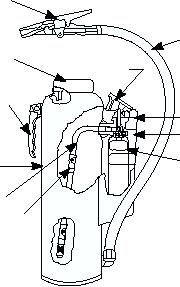
CHAPTER 5
PORTABLE FIRE-FIGHTING AND DEWATERING
EQUIPMENT
fires of gas turbines or jet engines unless absolutely
Learning Objectives: To recall the characteristics and
necessary because it also fouls engines. PKP is not
operation of various types of portable fire extinguishers,
effective on class ALPHA fires and can only be used to
oxygen breathing apparatus for fire fighters, shipboard
knock down flames and keep the fire under control
dewatering equipment and portable fans and blowers.
until an appropriate extinguisher can be used.
Aboard ship, Sailors use portable fire
NOZZLE
extinguishers to extinguish fires in compartments or in
t h e ga l l ey. A fi r e - fi g h t e r 's e n s e m b l e p r ov i d e s
protection for fire fighters, and the ensemble is
HOSE
enhanced by various types of oxygen breathing
FILL CAP
PUNCTURE
LEVER
apparatus (OBA) for use when fire fighting or
CARRYING
conducting gas-free testing or inspection.
HANDLE
Additionally, dewatering equipment, which includes
PULL PIN
CARTRIDGE
pumps and eductors, may have to be used when
GUARD
fighting fires along with other portable equipment,
GAS PRESSURE
SHELL
CARTRIDGE
such as fans and blowers. The characteristics and
operation of these types of equipment are presented in
GAS TUBE
this chapter.
CHECK VALVE
PORTABLE FIRE EXTINGUISHERS
Learning Objective: To recall the basic characteristics
DCf0501
Figure 5-1. Portable dry chemical fire extinguisher.
and operation of various types of portable fire
extinguishers.
PKP extinguishers come in an 18-pound and a
Portable fire extinguishers are used aboard all
27-pound size. Most PKP extinguishers have a small
Navy ships, and the three types most often used are as
CO2 cartridge mounted on the outside of the
follows:
extinguisher shell. This cartridge provides the
Dry chemical
propellant charge for the extinguisher. Do NOT
pressurize the PKP extinguisher until you are ready to
Carbon dioxide (CO2)
use it.
Aqueous film-forming foam (AFFF)
The steps of the procedure you should adhere to
when operating a dry chemical extinguisher are as
DRY CHEMICAL EXTINGUISHER
follows:
Portable dry chemical extinguishers (fig. 5-1) are
Step 1.
Carry the extinguisher to the scene of the
u s e d p r i m a r i l y o n c l a s s B R AV O f i r e s .
fire.
Purple-K-Powder (PKP) is the chemical most often
Step 2. Remove the seal and pull the locking pin
used in these extinguishers. The dry chemical
from the puncture lever marked PUSH.
dispensed from the extinguisher interrupts the
Step 3. Push the puncture lever down to penetrate
chemical reaction producing a fire and this action stops
the seal of the CO2 cartridge. The extinguisher is now
ready to use.
Dry chemical is also safe and effective for use on
Step 4. Approach the fire from the windward
class CHARLIE fires; however, carbon dioxide is
side, if possible. Hold the extinguisher in one hand and
preferred because PKP fouls electrical and electronic
components. Also, PKP should not be used on internal
the nozzle in the other hand.
5-1

